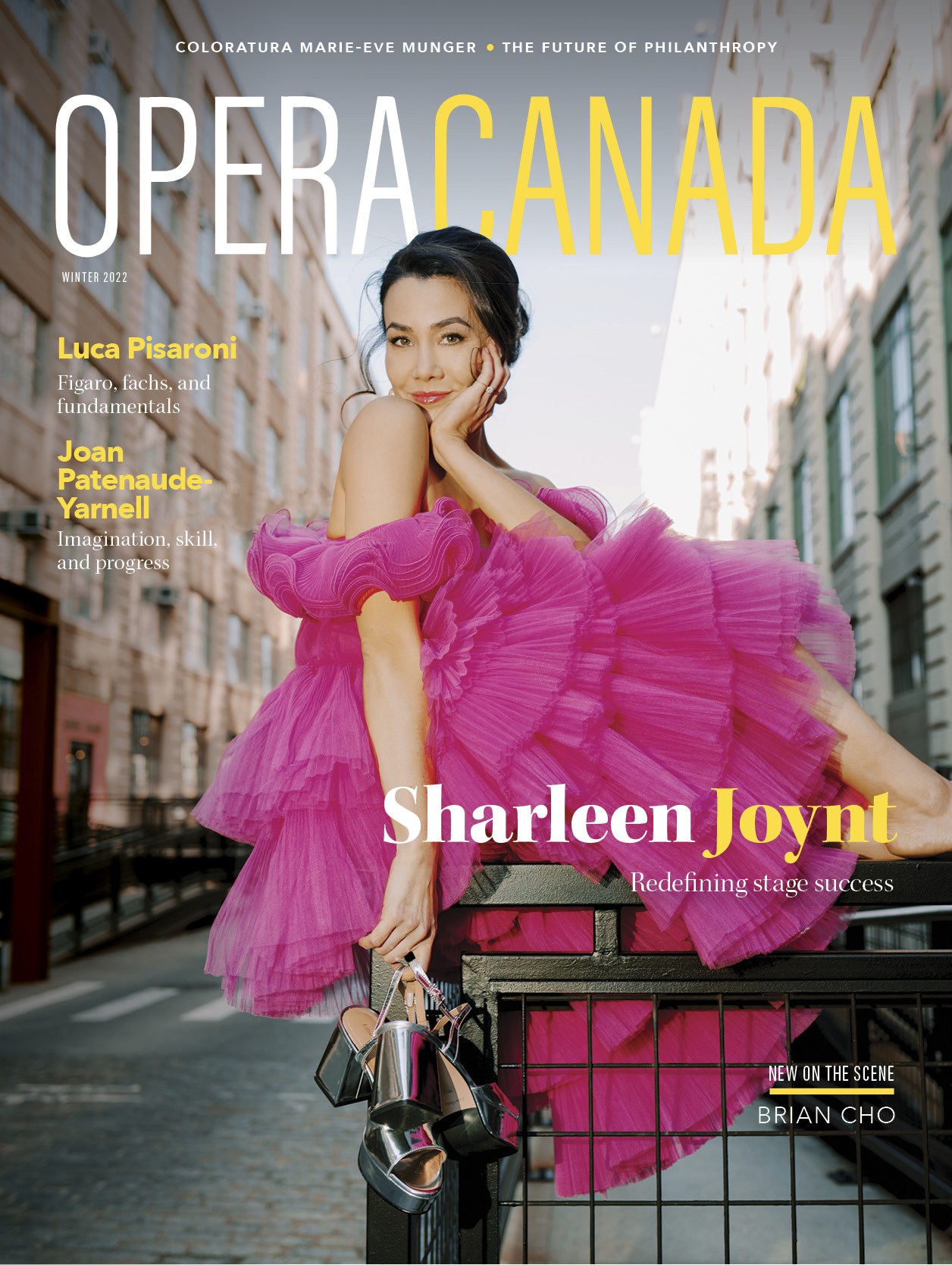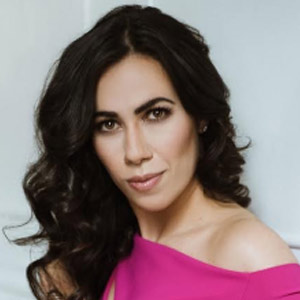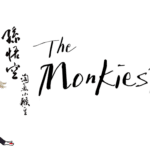SUBSCRIBE TO DIGITAL AND/OR PRINT MAGAZINE
*this text was originally published in the winter 2022/23 print version of Opera Canada magazine
When we look at the future of the performing arts, we need to delve deeper into what inspires private donations from patrons.
Development professionals in the arts do exceptional work for far less than they could earn in the healthcare or post-secondary education sectors. But for Canadian arts, fundraising is simply too short-term. Still defining what its culture should be; this country needs arts organizations to identify and cultivate connectors who will in turn enlist others. We need community builders.
In profiling a few such leaders and innovators here, may generous Canadians and strategically-minded organizations see the value in energetic evangelizing. The sector needs far more dialogue, asking those with the means what sorts of experiences they want. The search transcends race and culture—look to the wealthy, successful Chinese, Cantonese, Indian, and Italian communities on Toronto’s doorstep. If only opera leaders would drive out to meet them! This process cannot entirely transcend class, however, and that is okay. Opera has always been and will always be niche. Indie opera and school outreach programs serve important educational and inclusive functions, yet media’s flitting, shallow gaze invariably rests on younger, hipper audiences who cannot possibly contribute to capital funds. Instead, consider inter-generational growth from the other end, where niche denotes cultivated, experienced and affluent. Where like-minded people keep coming back because they have both the time and the resources to do so. This is patronage. Less ageism and more aggressive pursuit of those coming into their opera years, giving them a personalized, customer experience and teaching them to bring their friends. Because they’re the future, too, leaving legacies to pay the bills. ‘Twas ever thus—our art relies on citizens who understand it as their civic duty to give back to their community and their culture.
No couple better exemplifies this community-building than Jan and Larry Fichtner. Larry has served as a director of the Honens International Piano Competition, the Banff Centre, the Calgary Philharmonic Orchestra, and the National Arts Centre. Standard-bearers for the patron-vanguard, they galvanize others to throw open their homes, brandish their fountain pens and facilitate meaningful human interactions between the patrons, the artists and the organization as a whole. Here too, a call for artists to be educated in the financial realities of producing opera. Certainly, a healthy tension between those who make the art and those who pay for it is fruitful for expression. Patrons are enriched by music, but artists could benefit, too, from learning about strategy, finance and leadership. Mezzo soprano, producer and host of CBC’s Tempo, Julie Nesrallah elaborates:
“Larry and Jan’s hospitality and genuine interest in our Carmen Under the Stars meant that we artists were treated like superstars and human beings.” Innovative, responsive organizations like Honens have homed in on connectors like the Fichtners, working closely with them to crack the community open, listen to it and program accordingly.
The Canadian Association for the Performing Arts (CAPACOA) summarizes their 2017 study Vital Signs: Arts and Belonging thusly: “Canadians who rate arts, culture and leisure in their community as ‘excellent’ are nearly three times more likely to report a ‘very strong’ sense of belonging to their city.” In addition, “nine in ten Ontarians strongly agree that participating in arts builds a shared sense of community identity.” Montreal’s 2013 report, Capacity for Creative Connectivity, adds that “creative clusters attract the ‘creative class’—high-tech workers, architects, engineers, computer scientists, and other highly sought-after professionals.”
What follows are conversations with Larry and Jan Fichtner and friends and family they’ve recruited, as well as thoughts on development from the artistic vantage with James Ehnes, internationally-acclaimed Canadian violinist and Artistic Director of the Seattle Chamber Music Society

Larry and Jan Fichtner © Monique de St. Croix
Why support the arts over other worthy sectors or institutions? In other words—what’s your pitch to other generous people?
Jan Fichtner: Our musical journey started in 1992, hosting pianist Jean Efflam Bavouzet when he was competing in the inaugural Honens piano competition. He and his wife remain dear friends to this day. Since then, we’ve had amazing artists, from all genres, come into our lives and home, which is the only way to really get to know these talented people.
Here, the Fichtners have expanded the community, encouraging their friends, Janine LaBossiere and Dave Taylor to get involved. The former is a French as Second Language teacher and the latter, a recently retired CEO in the oil and gas industry.
Janine LaBossier: At the Honens Honours gala, Jan and Larry spoke of the return on investment—how enriched their lives have been by music and artists. From the Fichtners we’ve learned that monetary contributions are
necessary; but opening one’s home means you befriend amazing people who see life and art differently. Instead of a brief moment of self-satisfaction from a cheque delivered, you welcome someone into your lives. I think that we now
look at performances and understand that these are people with loves, challenges and dreams. It is so good help out in such a personal way.
James Ehnes: Music can bring something wonderful to people. Jan and Larry share an understanding with the great philanthropists through history: they can’t rely on other people to make things happen. And that if it means that
much to them, it means that much to a lot of other people that have not had the good fortune that they’ve had. That’s a certain brand of social responsibility that runs through the history of art.
Larry has been a board member and leader of many arts organizations across the country, in good times and bad. Where to start and how to build?
Larry Fichtner: Capital Development (building long-term capital, the interest of which feeds operations) is essential as a starting point, as it must fill the gap between what an organization can generate through earned revenue (ticket sales, special events, donor gifts, and corporate sponsorships) and government funding. The lower the percentage of cost covered by earned revenue and government funding, the greater the long term capital required.
As my rule of thumb, it should be at least three to five times the operating budget of the organization. Ad-hoc fundraising distracts from their core business (making music, producing opera, etc.). It also usually happens near year-end. That’s also when Preservation Campaigns are usually launched—each time for the last time…we promise. Instead, build and embrace a solid base of dedicated patrons, develop a program of multiyear commitments from them. And ask them: how are we doing?
What about even longer-term? Curtis Fichtner, son to Jan and Larry and VP Business Development at KeyOps, on how to transfer and expand patronage
through the generations:
Curtis Fichtner: The greatest challenge facing arts patronage is transferring the passion and support to Gen X, Y, and Z. The boomer generation, currently the largest base of support, is used to a high touch, personal relationship with the arts. The next generation has access to an exponentially larger community of digital peers as well as options for entertainment and content.
Even those of us who have had personal exposure at a young age may not be there yet due to other priorities competing for our time and money. The desire
to support is very real and simply a function of when. This will require creativity and collaboration not just between the various genres of performance arts, but perhaps more importantly between the current and future patrons in Canada.
In a time of almost satirical polarization, could we not use patronage to find commonality, more explicitly? Everyone at a show has something meaningful in common: love of art. Not all art is political advocacy. People searching for community could find it in a love of beauty for beauty’s sake.
James Ehnes: In Seattle one of the most successful aspects of our organization is our very, very close-knit, audience base. It’s where they go to be around people that share interests and passions and over time they
develop a shared history. I’ve been Artistic Director for 11 years and people ask if I spend a lot of time doing donor cultivation, but it’s really about understanding people’s passions and seeing ways we can work together to come up with something to interest and inspire others. We’re building community.
And as an artist in leadership, you can speak authentically and expertly to this shared passion and responsibility.
James Ehnes: Looking at economics and finance should be a part of music education; understanding that if you’re a serious musician, you need to run a business. How hard is it to say thank you to the people that pay your mortgage? The truth is that the art form is not sustainable without cultivating the people who literally pay the bills.
How can we foster more interdisciplinary thought and overlap between siloed arts organizations?
Larry Fichtner: Collaboration and consolidation are big issues here. There are very many small arts organizations that feel that they have a unique raison d’être. I don’t buy that—egos drive those thoughts. There should be far more administration sharing. There should be a significantly greater collaboration between genres—rather than fearing audience cannibalization, the thought should be that more is on offer and the audience will benefit and grow. Regional orchestras often resist this.
Why not get together and get economies of scale? Their audiences are totally separate, in different cities! Why are they not studying and building on the best practices of their peers in the industry?
There are clearly more connections to be made—between patrons and artists, and artists and patrons, and between the companies within the sector—as we continue to cultivate new audiences and drive accessibility programs. With Ehnes living in the United States, his perspective is valuable:
James Ehnes: Being a Canadian living in the States and doing a lot of work in Europe has been interesting. When things are going well, people see that as evidence that their system works. And when things aren’t, they point elsewhere. In Europe people say, our model is broken here. We need a culture of private sponsorship like you have in the States. We need people to understand that it is ultimately going to be up to them as individuals. I benefited greatly from the Canada Council, among others. It isn’t the case that public support is somehow useless. Not at all. But it’s a very common misunderstanding in Canada that government money plays a much bigger role than it does or than it really ever can.
People like the Fichtners, they deserve all the credit in the world for doing what they do, but they also deserve all the credit in the world for being the examples that people can look at.











